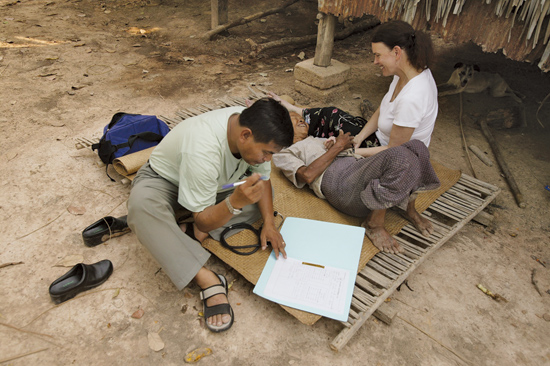A new method of treating patients infected with both HIV and tuberculosis could save countless lives in the developing world, where nearly half a million people die every year from a deadly combination of the two diseases.
The technique does not require expensive new drugs or therapies. It’s a simple matter of timing.
American, French and Cambodian researchers working in Cambodia found that when they started the HIV regimen, or highly active antiretroviral therapy (HAART), two weeks after beginning TB treatment, the risk of death was reduced by 34 percent compared to starting HAART after eight weeks.

Standard practice is to delay HIV treatment until eight weeks after TB treatment is initiated.
Anne Goldfeld, HMS professor of medicine at Brigham and Women’s Hospital, professor in the HSPH Department of Immunology and Infectious Diseases, senior investigator at the Immune Disease Institute (the Program in Cellular and Molecular Medicine at Children’s Hospital Boston), and cofounder of the Cambodian Health Committee (CHC), is the senior author of the report, which was presented in July at the 18th International AIDS Conference, in Vienna.
Goldfeld has described the two infections as a “match made in hell.” An estimated 1.37 million people are infected with both diseases, and a quarter of all deaths among HIV patients are caused by TB. The combination is doubly lethal since the AIDS virus depletes the body’s immune system, making it vulnerable to TB, while the TB bacterium promotes HIV replication.
In a randomized clinical trial called CAMELIA (short for Cambodian Early Versus Late Introduction of Antiretrovirals), Goldfeld and her colleagues treated some 661 patients between 2006 and 2010, all with extremely weak immune systems (see Focus, Aug. 28, 2009). The trial was part of the delivery and discovery network of the CHC. Half of the patients received HIV drugs two weeks after beginning TB treatment, and the other half received them eight weeks afterwards. Significantly more people died in the eight-week group compared to the two-week group.
“Our results can be implemented into clinical practice without delay, to better use medicines we already have in hand, to save countless lives around the world,” said Sok Thim, a cofounder, with Goldfeld, of the CHC and a co-principal investigator of the study along with Goldfeld and F. Xavier Blanc of France.
Basic immunological studies are also being conducted on patient samples from the CAMELIA trial by Goldfeld and colleagues to understand T cell responses and immunological mechanisms resulting in different clinical outcomes of HIV–TB coinfection. “This trial shows the power of working at the interface of basic discovery and delivery of care,” said Goldfeld. “Not only did we prove the hypothesis that early initiation of HIV treatment could enhance survival, we are applying cutting-edge immunological methods to understand the natural history of this disease while building a research network from scratch that has greatly improved quality of care for Cambodian patients in general with HIV and TB.”
For more information, students may contact Anne Goldfeld at goldfeld@idi.harvard.edu.
Conflict Disclosure: The authors declare no conflicts of interest.
Funding Sources: The French National Agency for Research on Aids and Viral Hepatitis (ANRS), the U.S. National Institutes of Health and the Annenberg Foundation; the authors are solely responsible for the content of this work.


